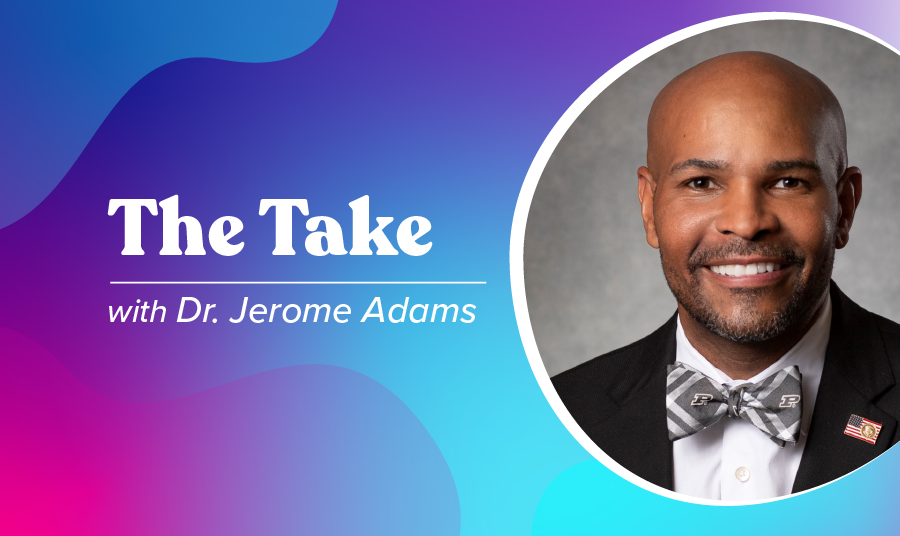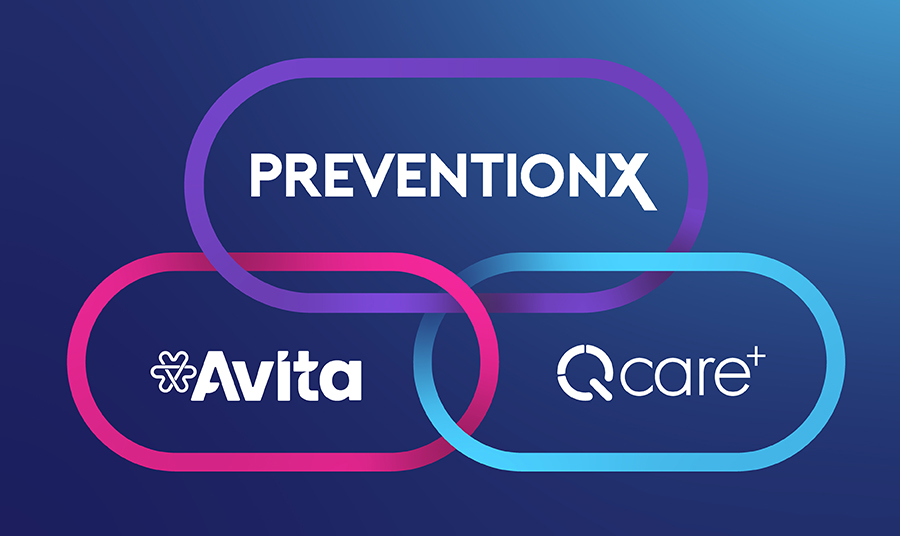With the continuation of the COVID pandemic, mpox (monkeypox), drug manufacturer challenges to the 340B program, and legislation impacting preventative care and discriminating against the LGBTQ+ community, covered entities bravely faced a host of challenges in 2022. In this edition of “The Take,” Avita Chief Advocacy Officer Glen Pietrandoni chats with Presidential Fellow and the Executive Director of Purdue’s Health Equity Initiatives, former U.S. Surgeon General, and Avita Board Member Dr. Jerome Adams about how grantees can boldly keep their eyes on the ball in the new year, why partisanship is the enemy of public health, and how thoughtfully creating strategic partnerships can make or break an organization’s mission.
A challenged 340B program that’s more important than ever
Glen: With the continuation of the COVID pandemic, mpox (monkeypox), drug manufacturer challenges to the 340B program, and legislation impacting preventative care and discriminating against the LGBTQ+ community, covered entities faced overwhelming challenges to their missions in 2022. What are your insights on this from your position on the front lines of health care?
Dr. Adams: First, it’s important to understand that I’ve seen the 340B program and the patients served by the 340B program from multiple angles. I’m a practicing clinician who works at a county hospital with covered entity status that serves many 340B patients. We benefit as an institution from the 340B program and believe in its intent to stretch scarce federal resources, reach more eligible patients, and provide increased comprehensive services. I’ve also been in a policy position. I have a viewpoint on the 340B program from running a State Department of Health and understand the impact 340B can have on the underserved, particularly on patients living with HIV. Finally, as a U.S. Surgeon General and a member of the Federal Department of Health and Human Services, I’ve gained a unique outlook on the program.
My take is that the people who were hardest hit by the pandemic are the same people who get hardest hit by everything. They belong to marginal communities. They’re part of the LGBTQ+ community. They’re Black and Brown people. They’re folks who live in rural areas. They’re people who have difficulty accessing services, which again is why it’s so important that we have a robust 340B program to extend services to them.
My concern predates the pandemic; I was focused on increasing access and quality of care for these folks well before the pandemic started. But the pandemic made a lot of existing problems much worse. So now we have a “pandemic deficit” in preventative care and outreach. People have been disconnected from care for their substance use disorders, HIV treatment, and hepatitis C screenings and care. It’s incumbent upon us to recognize this and to really lean into getting those folks engaged and re-engaged with care.
My take is that the people who were hardest hit by the pandemic are the same people who get hardest hit by everything. They belong to marginal communities.
Dr. Jerome Adams
The danger of framing public health through the lens of partisanship
Glen: There’s no doubt that politics plays a role here. Can you speak a bit about that?
Dr. Adams: More than most people, I understand how politics often hurts our ability to craft and implement effective health policy. You’re never going to be able to take politics out of health care and health policy in the U.S. What we should strive to do is to take the partisanship out of it.
I like that states have the flexibility to design programs and develop policies that work best for them. Because what’s going to work in L.A. County isn’t necessarily going to work in rural Indiana. But we shouldn’t be in a position where we see differential outcomes consistently based on the partisanship of a particular area. That deeply concerns me, and I have fought to help people understand the benefits of promoting health for everyone.
A real example is in Scott County, Indiana, where we had a historic HIV outbreak related to injection drug use, and where syringe service programs were previously illegal. I successfully demonstrated to state legislators and the local community that an intervention once viewed as very progressive politically [needle exchange] was necessary to quell that HIV outbreak and help the town get back to some semblance of normal. We must do more of that. We have to frame public health through a financial lens, through a moral lens, and through the lens of the community versus just through the lens of a political party.
We have to frame public health through a financial lens, through a moral lens, and through the lens of the community versus just through the lens of a political party.
Dr. Jerome Adams
How covered entities can keep their eyes on the ball
Glen: That leads to my next question: What advice do you have for our community health centers and FQHCs (Federally Qualified Health Centers) in terms of getting back to their original missions and keeping their eyes on the ball despite ongoing distractions?
Dr. Adams: My response is that there are covered entities in every state. And we need to realize that they’re all going to exist in different political climates. So, we must support them in those different climates and allow them to continue to stand up for what’s best for their patients.
When covered entities can avoid partisanship and focus on health policy, they’re better off. Here’s a very tangible example: In Indiana, we used ACA (Affordable Care Act) funds to expand health coverage to people during our HIV outbreak. Many conservative states have had difficulty doing this because the ACA is also called Obamacare, and you can’t be a red state governor expanding Obamacare. Partisanship is even there in the nickname of the initiative, and it hurts our ability to provide care. But in Indiana, when we focused on the actual root issue—that people deserve access to high-quality, affordable care—we were able to get it across the finish line.
Covered entities must remember that their mission is to focus on their patients. When they do that, things often tend to work themselves out. Politics is part of this, and it doesn’t mean that covered entities shouldn’t be involved in the political process. But often, it doesn’t help when we reveal ourselves to be blatantly partisan, especially if those views go against the political sentiments of the communities where we’re trying to work.
You're never going to be able to take politics out of health care and health policy in the U.S. What we should strive to do is to take the partisanship out of it.
Dr. Jerome Adams
The power of 340B success stories
Glen: During this year’s 340B Coalition Summer Conference, you spoke of the need for covered entities to tell their success stories in the face of attacks on the program. Beyond showing their impact to legislators and other 340B decision-makers, why are these success stories critical to building patient trust and community engagement?
Dr. Adams: The 340B program has been around for a long time. There are very impactful elements of the program, and there have been challenges. To quote George Bush, “We often judge ourselves by our best intentions while judging others by their worst examples.” There are examples out there making their way to legislators’ desks of the 340B program not accomplishing what it was designed to do. We must acknowledge this and share positive stories of the 340B program empowering covered entities to reach the previously unreachable and get people connected to care. Quite frankly, we need to drown out those few bad stories with all the success stories that exist. That’s how you keep 340B alive. We also must partner with legislators to continue to improve the program.
As you mentioned, 340B success stories also impact community engagement. We know that many of the folks helped by the 340B program also have historically well-founded reasons to mistrust the health care system. So, we’re already operating from a deficit of trust. Telling success stories creates one more reason for individuals to trust covered entities. When potential patients learn you’ve helped others in the community, it gives them a reason to overcome their inherent distrust and give you a chance. Once they give us an opportunity, we have to deliver, but telling those stories often opens the door to building relationships.
When potential patients learn you've helped others in the community, it gives them a reason to overcome their inherent distrust and give you a chance. Once they give us an opportunity, we have to deliver, but telling those stories often opens the door to building relationships.
Dr. Jerome Adams
Why building a network of trusted partners is crucial
Glen: How and why are strategic partnerships with pharmacy services providers, a network of trusted health care providers, advocacy groups, and other community stakeholders crucial to the well-being of covered entities and their patient bases in the face of the above challenges?
Dr. Adams: We all have different hats we wear, levers we can pull, and networks we can access. I switch back and forth between those worlds when I’m a physician working in the hospital versus when I’m a professor doing research at Purdue University versus when I’m a policy advocate at the statehouse or when I was a policy maker in my previous roles of health commissioner and surgeon general. We need to help covered entities form strategic partnerships between all these groups and more, including advocacy groups and community stakeholders.
For example, pharmacy services providers often know how to help patients find financial assistance to reduce their medication costs. When we have integrated relationships between all the different partners in the delivery care system from top to bottom, patients will have better experiences, and we will have better outcomes. That’s why it’s incumbent upon us to recognize our silos and work to tear them down.
When we have integrated relationships between all the different partners in the delivery care system from top to bottom, patients will have better experiences, and we will have better outcomes. That's why it's incumbent upon us to recognize our silos and work to tear them down.
Dr. Jerome Adams
The role of for-profit partners in program sustainability
Glen: What about covered entities having partnerships with for-profit organizations?
Dr. Adams: I’m glad you brought that up Glen, because a partner group we often don’t think about— and that’s often disparaged—are our for-profit partners. But the reality is, whether we like it or not, the U.S. health care system is largely a for-profit health care system. And if we want program sustainability, we need to consider at least how to involve for-profit partners.
Often covered entities have alignment in their missions but need a partner to help them think through and develop a plan for sustainability. Whether that’s how to capture state Medicaid dollars, access 340B funding, or explore new ways to bundle payments to address social drivers of health, for-profit partners can get covered entities beyond periodic grant funding and philanthropic donations. Because let’s face it, covered entities that become overly reliant on philanthropic funding and grants without a plan for sustainability may find themselves left high and dry.
For-profit partners can get covered entities beyond periodic grant funding and philanthropic donations. Because let's face it, covered entities that become overly reliant on philanthropic funding and grants without a plan for sustainability may find themselves left high and dry.
Dr. Jerome Adams
What's ahead in 2023
Glen: Okay, crystal ball time. What do you think the top issues facing covered entities in 2023 will be?
Dr. Adams: Unfortunately, we will continue to see the politicization of health issues. And once again, it will be incumbent upon us to get past the partisanship to meet patients’ needs. This isn’t going away, and we’ve got to figure out how to advance despite politicization.
Another big issue is all the missed screenings, preventative care, and primary care during the pandemic. So many people fell out of care; we must make a concerted effort to reengage them.
Finally, we need to focus on integrating mental health with physical health. We know that suicides, substance use, anxiety, and depression went up during the pandemic. It’s going to be more critical than ever that we practice whole-person health and address peoples’ mental, emotional, and spiritual needs instead of only focusing on their physical needs. Because if we forget the former, we’ll have a more challenging time engaging people for the latter.
It's going to be more critical than ever that we practice whole-person health and address peoples' mental, emotional, and spiritual needs instead of only focusing on their physical needs. Because if we forget the former, we'll have a more challenging time engaging people for the latter.
Dr. Jerome Adams
Proactively focusing on the future
Glen: Final question for you: What pet projects are you working on for next year?
Dr. Adams: I’m focused on three main areas in my work at Purdue. The first is mental health and substance use, which is the number-one issue that repeatedly comes up when talking to communities. We may want to speak to them about hepatitis. We may want to talk to them about HIV. We may want to speak to them about COVID vaccines, but at the end of the day, they bring up mental health as their top concern. We need to listen to people and address these issues if we want to be seen as good community partners.
A secondary area I’m focused on is food for health. A lot of the people covered entities serve struggle with food insecurity. We need to address that in a way that doesn’t lead to obesity or malnutrition. This is another key service area covered entities should start thinking about to engage patients.
The third initiative I’m leaning into is infectious disease. Throughout my career in chronic disease prevention, I’ve found that no matter how much you want to talk about hypertension or cancer or diabetes, you’re always going to run into an HIV, hepatitis, COVID, mpox (monkeypox), or STI outbreak. So, we need to focus on controlling and preventing infectious diseases. If we don’t, they’ll continue to suck all the air out of the room and prevent us from dealing with other major health issues impacting our communities. There’s no better example of this than COVID.
We need to focus on controlling and preventing infectious diseases. If we don't, they'll continue to suck all the air out of the room and prevent us from dealing with other major health issues impacting our communities.
Dr. Jerome Adams
What’s your take? Whether you have an idea for a future guest or topic for our blog post series or would like to comment on the insights of one of our past guests, we’d love to hear from you! Reach out to us on social media on our LinkedIn, Twitter, and Facebook channels.
About Dr. Jerome Adams
Dr. Jerome Adams was appointed as a Presidential Fellow and the Executive Director of Purdue’s Health Equity Initiatives on October 1, 2021. He is also a Distinguished Professor of Practice in the departments of Pharmacy Practice and Public Health and an Avita board member.
As the 20th U.S. Surgeon General and a prior member of the President’s Coronavirus task force, Dr. Adams has been at the forefront of America’s most pressing health challenges. A regular communicator via TV, radio, and in print, Dr. Adams is an expert not just in the science, but also in communicating the science to the lay public and making it relevant to various audiences.
Dr. Adams is a licensed anesthesiologist with a master’s degree in public health and ran the Indiana State Department of Health prior to becoming Surgeon General. In the State Health Commissioner role, he managed a $350 million dollar budget and over 1000 employees, and led Indiana’s response to Ebola, Zika, and HIV crises. Notably, Dr. Adams helped convince the Governor and State Legislature to legalize syringe service programs in the state, and to prioritize $13 million in funding to combat infant mortality. As Surgeon General, Dr. Adams was the operational head of the 6000-person Public Health Service Commissioned Corps, and oversaw responses to 3 back-to-back category 5 hurricanes, and to a once-in-a-century pandemic.
In addition to his recent COVID-19 work, Dr. Adams has partnered with and assisted organizations as they navigate the opioid epidemic, maternal health, rising rates of chronic disease, the impacts of rising suicide rates in our nation, and how businesses can become better stewards and stakeholders in promoting community health.
About Glen Pietrandoni
Glen is chief advocacy officer at Avita, an award-winning pharmacy leader, passionate 340B program advocate, and internationally respected HIV and LGBTQ+ activist. He’s deeply engaged in Avita’s mission to advocate for health equity and the 340B Drug Pricing program and works to bring together stakeholders from the pharmaceutical industry and patient advocacy arenas.
Through webinars, conferences, Avita’s thought leadership blog series “The Take,” and the organization’s engagement with multiple community and trade associations, Glen leads Avita’s educational and awareness efforts and acts as a voice for its covered entity partners and patients. He continually fights for continued access to the 340B program and advances stigma-free HIV, PrEP, LGBTQ+, and sexual wellness care for underserved patient populations.
Glen recently received Pharmacy Times’ Lifetime Leadership honor at the Next-Generation Pharmacist awards. He serves on the Board of Pharmacy for the State of Illinois, was formerly chairman of the Board of Trustees of AIDS United, and sits on the board of Community Voices for 340B (CV340B). He has earned American Academy of HIV Medicine and Apexus 340B certifications.




